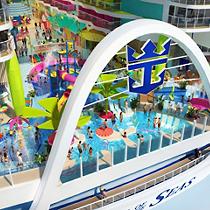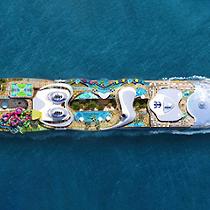New Technology On Cruise Ships: How Icon Of The Seas Is Making Waves
New technology on cruise ships is driving Innovation at sea — see how cutting-edge technology on Icon of the Seas is enhancing the guest experience.
By Donna Heiderstadt | Published on May 02, 2025
Innovation is at the heart of the modern cruise vacation, from the splashy new technology on cruise ships used to create groundbreaking entertainment and improve the guest experience to sophisticated behind-the-scenes systems designed to enhance energy efficiency and sustainability.
There's no better example of how cruise lines are embracing modern technology than the Icon Class ships. The Icon Class launched in early 2024 with the debut of the 5,610-guest Icon of the Seas®, which sails year-round to the Caribbean and The Bahamas from Miami and introduced several awesome firsts at sea: the largest swimming pool (plus a suspended adults-only aft infinity pool and a swim-up bar), the biggest ice arena and the twisting, turning Category Six waterslides at Thrill Island. The second Icon Class ship, Star of the Seas℠, launches in summer of 2025, with Caribbean and The Bahamas itineraries from Orlando, Florida (Port Canaveral) year-round. Intrigued? Read on for a look at the technology fueling these exciting new ships.
Innovative New Features
Ensuring the stability of a 20-deck, almost 250,000-gross-ton cruise ship takes years of design work by top engineers and naval architects, especially when the ship features not only the forward-facing AquaDome℠, but also several sizeable swimming pools and a 17,000-square-foot water park with six towering slides on its top decks. But hey, that's par for the course for a cruise line that decided two decades ago to put an open-air park with thousands of live trees and plants — Central Park®, a popular neighborhood on Oasis Class and Icon Class ships — in the middle of a deck.
The Pearl℠
Perhaps the most-buzzed-about technological innovation on Icon Class ships is The Pearl. It's designed as the centerpiece of the light-filled, next-generation Royal Promenade, where every guest boards on day one of their cruise. Talk about making a big first impression: An utterly irresistible photo-op, The Pearl is a glittering, three-deck sphere that dazzles with an experiential art installation of 3,600 computer-driven kinetic tiles synched with music. It's a vibe. It's also structurally load-bearing — the design allows for four-deck-high panoramic windows in the Pearl Café℠ that take advantage of daylight and offer sweeping ocean views. Another cool fact: The Pearl itself weighs more than a Boeing 747 aircraft.
Elevators
I never thought I'd say this, but one of the things that most impressed me during my time on the world's largest and most innovative cruise ship was — wait for it — the elevators. Yes, Icon of the Seas' elevators make it extremely easy to explore this massive ship's 20 decks and eight incredible neighborhoods in a timely and crowd-free manner. How so? Efficiency. Not only do the ship's two elevator banks — located forward and midship in spacious oval atriums holding a combined total of 22 elevators — feel less cramped, but they also use programming by their manufacturer, Kone, to minimize waiting time.
With destination dispatch elevators like these, guests use consoles to request their desired deck and the letter (A, B, C, D, etc.) of the next elevator stopping there appears. There's a sustainability factor, too, since the cars on the way up harness the energy generated by those on the way down. Better still, the elevators use AI to improve their efficiency over time-based on usage patterns throughout the day.
AquaDome
I also couldn't help but be wowed by AquaDome. Located at the top of Icon Class ships, AquaDome is a day-to-night playground that offers 220-degree ocean views plus a 55-foot shapeshifting waterfall, four robotic arms, fountains, a high-tech multimedia overhead canvas that's used for projections, a pool for acrobatic high-dive performances, several bars and restaurants, and a soaring space called The Overlook℠ that draws relaxation-seekers to its cozy pods and dreamy daybeds. The largest structure of glass and steel on a cruise ship, AquaDome weighs 363 tons. It took eight months to assemble before it was hoisted onto Icon of the Seas in the shipyard.
With AquaDome, as well as Chill Island℠ and Thrill Island, located on the upper decks, Icon Class engineers and architects faced an important challenge during the ship's design and construction. The higher the vertical center of gravity on a ship, the more impact that weight has on a ship's stability — something that needed to be taken into consideration not only during the initial design process and construction but also during every moment of the ship's operation. Advanced digital technology offered a solution: Icon of the Seas' designers used next-generation NAPA Stability software to determine the ship's stability parameters — and those same models are continually used during daily operations to aid decision-making when it comes to accurate stability calculations. NAPA Stability software constantly monitors the variables that may affect stability and real-time data is shared with onshore teams via the cloud-based NAPA Fleet Intelligence platform. This allows both the ship's crew and shoreside support teams to constantly assess stability data and flag any potential risks before a serious issue arises.
The Royal Caribbean App
Guest ease and comfort are also at the heart of the cruise line's latest smartphone app, which makes checking in, registering a credit card and completing the requisite health questionnaire a breeze. Even the tech-phobic will find the real-time activity calendar simple to scroll through — you'll never miss a trivia contest, dance party or DJ session at the Chill Island pools again. Plus, the app makes it easy to reserve specialty dining and shore excursions whenever you want.
Book Now
Sustainability Enhancements
Power and Navigation
Equally impressive as the wow-factor technology that powers some of the Icon Class's most innovative features are the sustainability-focused systems that power the ships themselves.
Icon of the Seas, which features six dual-fuel engines, is the first ship in the fleet capable of being powered by liquified natural gas (LNG), which is its main fuel. Icon of the Seas' engines are also designed so that any excess heat generated is harnessed and repurposed, while the cold from LNG (which is a cryogenic liquid) is used to increase the efficiency of the ship's air-conditioning system. What's more, the ship is "shore power ready," meaning it can be plugged into the local power grid when in port, where available, reducing engine output while shoreside.
Technological advancements also allow Icon of the Seas to embrace AI-based technologies to optimize the ship's route for maximum efficiency, while weekly robotic hull cleaning (said to make the ship 3-4 percent more energy efficient) is further enhanced by an air lubrication system of microscopic bubbles that coats the hull to reduce friction as it cuts through the water.
Water and Waste
When it comes to the water for onboard use, the facts are as impressive as Icon of the Seas is big. Would you believe that 93 percent of the ship's fresh water is produced onboard via a reverse osmosis/desalinization plant? The ship's environmental officer also tests the water daily.
With ships as massive as those in Icon Class, waste management also needs to be a top priority. This begins with the ships' wastewater treatment system, designed to treat every drop of water above regulatory standards. Meanwhile, a state-of-the-art waste-management room is at the core of the ships' recycling program, ensuring that more than 90 percent of trash generated on Icon Class ships never reaches a landfill.
Other innovative technologies used to reduce waste include WOW (Win on Waste), a custom-built app paired with a dedicated onboard team designed to reduce food waste. This and other front-end initiatives have slashed food waste by 24 percent. There is also a waste-to-energy system onboard that uses microwave-assisted pyrolysis to turn food and paper waste into synthesis gas that can be used as energy to power other onboard processes, such as the reverse osmosis system.
Energy Efficiency
New technology on cruise ships also plays a key role in maximizing energy efficiency. Staterooms on Icon Class ships have been designed to conserve energy. Using smart technology, eco mode turns on whenever a guest departs, triggered by a computer that detects when the last person in the stateroom scans their key card at the gangway. It turns back off, returning the air conditioning to pre-set levels, when the first guest returns and scans their card. This creates an optimal stateroom temperature when the space is occupied, but saves energy when it isn't.
Whether behind the scenes or at a guest's fingertips, the technological innovation onboard Icon Class ships is truly mind-blowing. The end result is a vacation experience that offers both full-throttle exhilaration and unparalleled efficiency along with the innovations in sustainability guests crave.
Get Royal Deals, Sign Up Today
Related Articles

The Ultimate Family Vacation Pools on Icon of the Seas
READ MORE

Icon of the Seas Reveal: What is Included in a Cruise With Royal Caribbean?
READ MORE

Kid-Friendly Restaurants on Icon of the Seas
READ MORE












